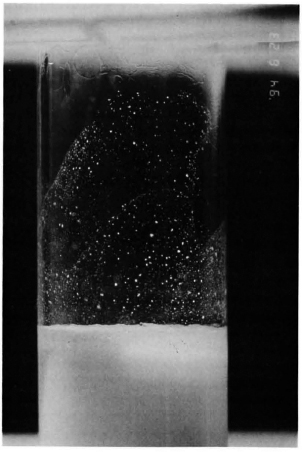- Volume 63 , Number 1
- Page: 100–1
An unusual spreading phenomenon in an artificial medium inoculated with M. leprae
To the Editor:
In 1874 Hansen reported Mycobacterium leprae as the causative agent of leprosy. Since that time only very limited multiplication of this mycobacterium has been reported from time to time on artificial media (3). Wheeler reported in 1990 that the de novo fatty acid synthesis of M. leprae is depressed and that M. leprae require an exogenous source of fatty acids for growth (7). Franz-blau described the oxidation of palmitic acid of M. leprae with an increased synthesis of phenolic glycolipid-I (PGL-I) (2). Kato, et al. reported the use of water-soluble complexes of palmitic acid and long-chain alcohols for the in vitro cultivation of leprosy-derived psychrophilic mycobacteria (4).
At the Armauer Hansen Institute/German Leprosy Relief Association, Wurzburg, Germany, a modified Ogawa medium was developed with the incorporation of different water-soluble fatty acids, water-soluble liposomes, purine precursors and catalase. The egg medium was poured horizontally. Over the remainder of the glass wall a thin layer of agar was deposited. The medium was inoculated vertically with an M. leprae suspension (200 μd, 1 x 108/ml) obtained from mouse foot pads previously inoculated with M. leprae. The tubes were incubated in a vertical position at 32ºC. Three to four weeks after inoculation a spreading phenomenon of the organism appeared in an upward direction (The Figure). The organism appeared to spread upward like a thin film in a wave-like motion from the horizontal inoculated surface of the medium on the glass wall of the tubes, which is suggested to be associated with bacterial growth.

The Figure. Spreading on the glass wall in a tube inoculated with M. leprae.
The bacteria which were spreading in an upward direction have been identified using a set of synthetic oligonucleotides [B-16S-27f(6), B-16S-341r(1) and B-16S-788r(6) homologous to broadly conserved sequences of 16S ribosomal RNA. The in vitro amplification of the 796 bp fragment of the bacteria with the polymerase chain reaction (PCR) was followed by direct sequencing of the PCR products. A comparison of these sequences with the published sequence resuited in a 100% homology, especially an insertion of 12 nucleotides unique for M. leprae at the 5' end of the 16S rRNA gene was found (5).
The significance of this finding is being investigated currently.
- V. Sticht-Groh, M.D., F.R.C.P.(C)
Appl. Professor of Microbiology
- G. Bretzel, Dr.
German Leprosy Relief Association/
Armauer Hansen Institute
Hermann-Schell Str. 7
97074 Wurzburg, Germany
- D. Harmsen, Dr.
J. Heesemann, Prof.Dr., Dr.
Department of Hygiene and Micrbiology
University of Wurzburg
Wurzburg, Germany
- M. Ishaque, Ph.D.
Armand Frappier Institute
Montreal, Canada
REFERENCES
1. Edwards, U., Rogall, T., Blocker, H., Emde, M. and Bottger, E. C. Isolation and direct nucleotide determination of entire genes; characterization of a gene coding for 16S ribosomal RNA. Nucl. Acid Res. 19 (1989) 7843-7853.
2. Franzblau, S. G. Oxidation of palmitic acid by Mycobacterium lepraein an axenic medium. J. Clin. Microbiol. 26 (1988) 18-21.
3. Ishaque, M. and Sticht-Groh, V. Investigations into the growth of Mycobacterium leprae in a medium with palmitic acid under different gaseous environments. Microbios 75 (1993) 171-179.
4. Kato, L., Szejtli, j. and Szente, L. Water-soluble complexes of C14 and C16 fatty acids and alcohols in media for cultivation of leprosy-derived psy-chrophilic mycobacteria. Int. J. Lepr. 62 (1994) 75-87.
5. Teske, A., Wolters, J. and Bottger, E. C. 16S rRNA nucleotide sequence of Mycobacterium leprae: phylogenetic position and development of DNA probes. FEMS Microbiol. Lett. 89 (1991) 231-238.
6. Weisburg, W. G., Barns, S. M., Pelletier, D. A. and Lane, D. J. 16S Ribosomal DNA amplification for phylogenetic study. J. Bacteriol. 173 (1991) 697-703.
7. Wheeler, P. R., Bulmer, K. and Ratledge, C. Enzymes for biosynthesis de novo and elongation of fatty acids in mycobacteria grown in host cells: Mycobacterium leprae competent in fatty acid biosynthesis? J. Gen. Microbiol. 136 (1990) 211-217.